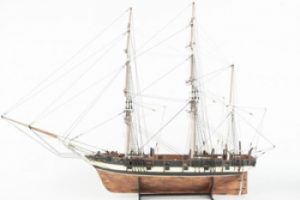A Packet Surgeon’s diary
20 June 2018
My attention was first drawn to the Williamson Journals in June 2005, following an enquiry to the Bartlett Library from a Douglas Williamson. Douglas wanted to know what we could tell him about one of his ancestors who had served in the Falmouth Packet Duke of York – James Williamson. At that time I assumed James must have served as a packet seaman. Finding nothing about him in our Packet records I pointed Douglas towards the National Archives at Kew, and the Royal Mail Archives at Phoenix House, London.
Douglas came back to me and informed me that James had served as Surgeon of the Packet Duke of York, and had kept written accounts of all his voyages. Written on loose sheets of paper (not all of uniform size) these had since been bound into two journals. With cursive writing, faded ink, and the occasional resort to a code or foreign languages, the journals were not easy to read, so Douglas and the current generation of Williamsons had only transcribed short passages of the journal.
Given that we had very little information about Packet Surgeons as such in the Bartlett Library at Falmouth, I was most intrigued and Douglas promised to bring them in for me to see the next time he was down in Cornwall. Towards the end of 2005 Douglas and his wife Jean brought in the journals allowing me a privileged, if all too brief, opportunity to peruse the journals. Their unique character relative to the Post Office Packet Service out of Falmouth was immediately apparent.
I was keen to work on the journals, but at the time Douglas was reluctant to leave them with me. However, he informed me that many years earlier (1984) the journals had been loaned to the National Maritime Museum in Greenwich, who had micro-filmed them. So far as he was aware they had not done anything in the way of publishing them.
With Douglas’s permission a copy micro-film of the journals was obtained from Greenwich with a view to producing a full transcription. By February 2007 I had worked through large sections of the Journals, but the text was illegible in many of the micro-film frames due to some water damage and very faded ink – packet cabins were far from water-tight. It was clear to me that I needed to work from the original journals if I was to succeed in producing a full transcription. By this time my relationship with Douglas had developed to a point where he felt he could trust me with the original journals, and later that year he placed them in my hands.
In June 2008 I was able to return the journals to Douglas Williamson, along with my heartfelt thanks for the privilege of being allowed to work on them, and for his permission for us at the National Maritime Museum Cornwall, to publish them in any way we saw fit – which in itself was to prove a challenging task.
Transcribing the journals had been as much a labour of love as an academic exercise, but over the twelve month period I was able to fully transcribe the whole of the two journals. Running close to 500,000 words it is a significant piece of work, revealing details of packet ship-board life of which we were completely ignorant, as well as providing an insight into James Williamson’s personality, character and scholarship. He was clearly a well educated young man, and his writing style develops over successive voyages. Each voyage account consists of an amalgam of navigational log-book style entries, diary notes, observations on places seen and visited, to mia cara Madre, and later in the series weekly summaries of events. Passages that he wished to keep from prying eyes he wrote in an Anglo/Greek code which – tho simple enough in retrospect – took some de-ciphering due to his cursive writing and faded ink. Confidential medical matters he tends to cover in dog-Latin – most of which I have not tried to translate – and which I fear may be unintelligibly in my transcriptions, lacking knowledge of Latin to make the intuitive grasp of what the words should have been by their context.
To my eternal regret Douglas Williamson died in May 2009, before this project reached fulfilment and we could publish the Williamson Journals. My thanks to Douglas, Jean and his family for their help and trust cannot be adequately expressed.
Much as one would have liked to see the journals published in full as a book (or books), the physical size precluded this, and for several years the question of a suitable mode of publishing has been trying the minds of the executive team at the museum.
Hopefully we have now come up with an acceptable solution. Now you, dear reader, can have voyage by voyage access to the Williamson Journals.
Tony Pawlyn : June 2011
The Bartlett Library : National Maritime Museum Cornwall
